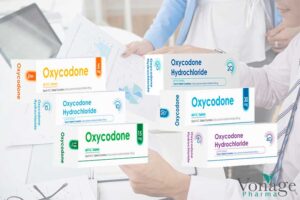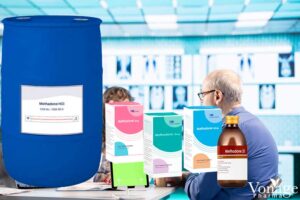Pharmacy providers desiring to purchase APIs for treatment with naltrexone and higher blood sugar levels are faced with a dynamic and growing market. Naltrexone, primarily known in the application of opioid and alcohol addiction treatment, is increasingly studied and applied in off-label applications for metabolic diseases with effects on blood sugar regulation.
With the emerging therapeutic application combined with growing demand and advanced supply chains, awareness of API procurement techniques is important. This report presents fact-based analysis in the naltrexone and elevated blood sugar market with a focus on procurement trends, market data, and strategic implications for drug manufacturers.
Market Overview: Expansion and Naltrexone API Demand
The overall picture is looking good for naltrexone hydrochloride active pharmaceutical ingredients (APIs) globally. The value of naltrexone hydrochloride APIs is expected to reach just below ~USD 1.1 billion in 2024, reaching ~ USD 1.8 billion by 2033, and a total CAGR of ~ 6.2% between 2026 and 2033. This has been buoyed primarily by increasing numbers of opioid and alcohol use disorder cases worldwide, combined with additional applications in impulse control disorders and weight control.
Addiction is by far the most common treatment indication for naltrexone; however, new studies indicate naltrexone may have a role in the regulation of insulin secretion and glucose metabolism (including states of hyperglycemia). Naltrexone treatment of women with hyperandrogenism, followed by observations of improvements in insulin levels (markedly reduced fasting insulin and c-peptide), suggests potential for improved insulin control without adverse effects on glucose. Such a pool of mounting evidence is also developing new treatments, causing naltrexone API demand for metabolic disorders.
Vonage Pharma, one of the premier manufacturing sites for pharmaceutical products, plays a critical role in the distribution of naltrexone in both formats of Naltrexone 50 mg and Naltrexone HCl API (Active Pharmaceutical Ingredient) dosages.
Global API Market and Supply Trends
From October 2023 to September 2024, approximately 1,100 batches of naltrexone APIs were imported worldwide, shipped by 122 suppliers to 206 buyers. Top traders are the United States, India, and France, while top buyers are Switzerland, Singapore, and the United States. Singapore alone shipped out 1,951 shipments, marking it a key pharmaceutical hub. This is a high number, yet the market has witnessed a mild drop of 17% in the rate of growth of shipments from one year to another, which may reflect tightening of supply chains or changes in demand trends.
To naltrexone APIs’ drug providers, this highlights the need to diversify providers and maintain close ties with numerous producers in order to guarantee supply continuity.
Sourcing APIs for Naltrexone and High Blood Sugar: Challenges
There are a number of problems that the pharma providers face when they source APIs for naltrexone and high blood sugar drugs:
- Regulatory Compliance: APIs fall under strict regulatory conditions, including GMP certification and heavy documentation, to ensure their safety and efficacy.
- Quality Assurance: Quality fluctuations in APIs are prone to affecting drug performance, especially with sensitive metabolic disorders.
- Price Volatility: Geopolitical tensions, exchange rates, and market volatilities can potentially affect API prices.
- Supply Chain Disruptions: Pandemics or trade embargoes are most likely to cause delays or shortages. With such issues, strategic sourcing techniques must be adopted.
Strategies to Help Maintain Stable Naltrexone API Supply
1. Diversify Supplier Base
Having a single supplier exposes them to more disruption. Having a multitude of GMP-approved API producers situated in other areas, like India, the U.S., and Europe, will decrease risks and present competitive pricing options.
2. Leverage Market Data and Analytics
Utilize platforms that provide real-time import-export data, price patterns, and supplier performance indicators. For example, Volza’s comprehensive import data on APIs of naltrexone enables buyers to compare prices, find reliable suppliers, and monitor shipment quantities.
3. Reach Long-Term Agreements
Count on stable supplies and better prices with long-term agreements with target suppliers, as prices should continue to be more tolerable as the market is on the rise and will have uncertain demand.
4. Focus on Quality and Compliance
Prioritize such suppliers with good regulatory compliance and quality certifications. For APIs related to metabolic disorders like hyperglycemia, quality consistency is of utmost importance to guarantee therapeutic effectiveness and ensure patient safety.
5. Monitor Current Research and Market Trends
Keep up to date with recent clinical research on naltrexone’s metabolic consequences, since broadening the indications would possibly drive demand upward. The global market for diabetes medications, currently USD 89.45 billion in 2024. It will grow at a 7.36% CAGR by 2030, indicating the immense potential in metabolic disease treatment.
Awareness of these trends enables forecasting API demand changes.
The Role of Technological Advancements
Pharmaceutical formulation improvements, such as extended-release and transdermal delivery systems, are improving patient compliance. These improvements expand the therapeutic uses of naltrexone.
These new platforms also affect API manufacturing needs. So, pharmaceutical suppliers need to be in very close collaboration with suppliers who can deliver shifting specifications.
Statistical Snapshot
-
Naltrexone Hydrochloride Market: USD 1.1 billion in 2024, estimated USD 1.8 billion by 2033, CAGR 6.2%
-
Global Naltrexone API exports: 1,100 for 12 months till Sep 2024, exported by 122 sellers to 206 buyers
-
Top sellers: India, USA, France; top buyers: Singapore, Switzerland, USA
-
Market size of diabetes medications: USD 89.45 billion in 2024, set to reach USD 137.17 billion by 2030, CAGR 7.36%. (Diabetes Drugs Market Trends)
-
Clinical study: Naltrexone lowered fasting insulin by 40% and C-peptide by 50% in hyperandrogenic women, indicating metabolic improvements. (Naltrexone effects on insulin sensitivity)
Conclusion
With API suppliers of drugs, naltrexone and hyperglycemia bring new opportunities and threats. They play key roles in a drug landscape. The naltrexone and high blood sugar relation targets common diseases and addiction therapy, and painlessly. The market is growing and facing unclear therapeutic applications. It evolves supply chains and adapts API sourcing, which requires a procurement strategy based on evidence, claims, and quality.
Vonage Pharma helps pharmaceutical manufacturers secure reliable supplies of naltrexone API. It leverages market health, pharmacy knowledge, and evidence intensity to make its play in the expanding naltrexone API market. By staying up-to-date with market information and clinical developments, suppliers are able to create supply chains. Also, they can aid in the spread of better patient care in addiction as well as metabolic diseases.







